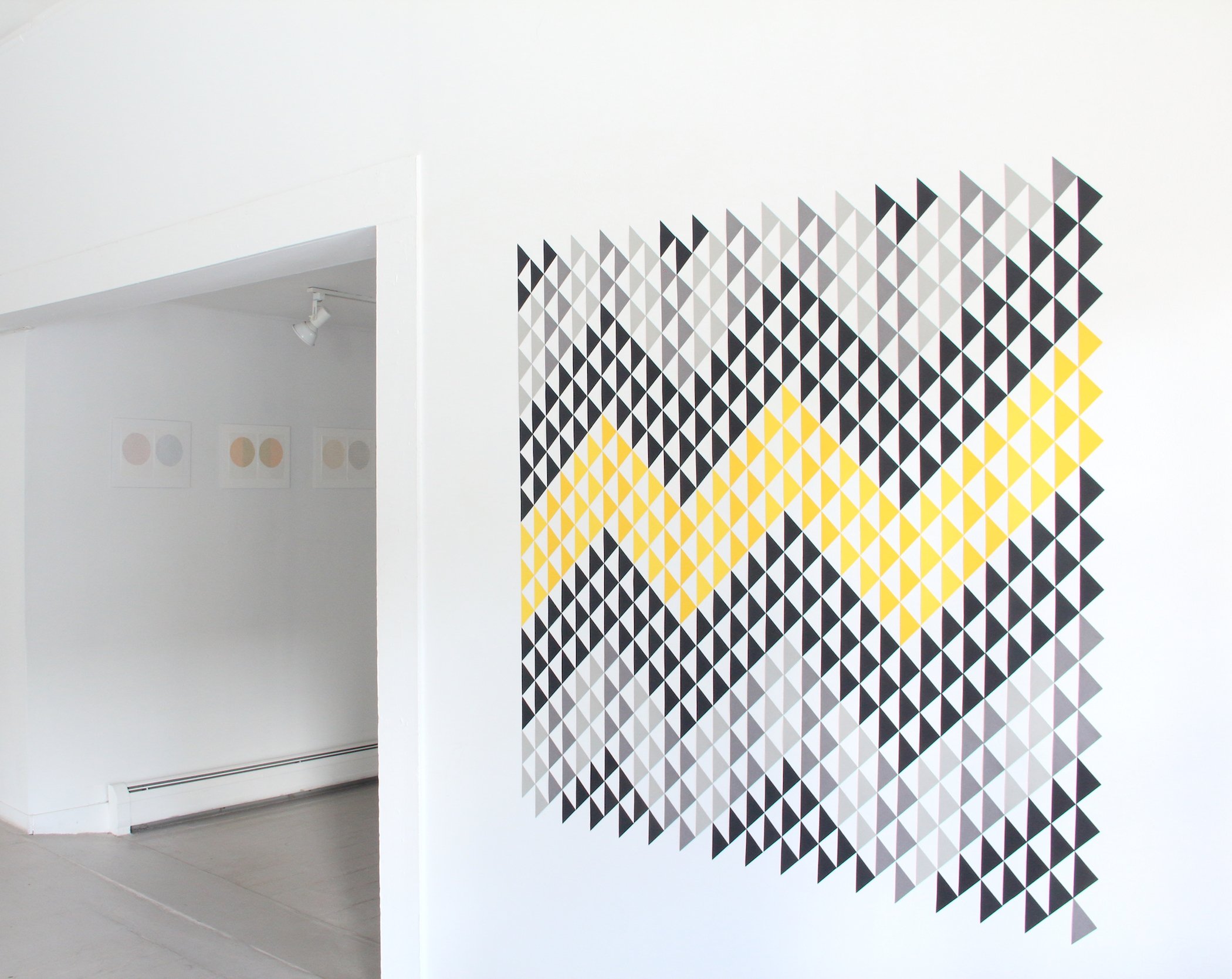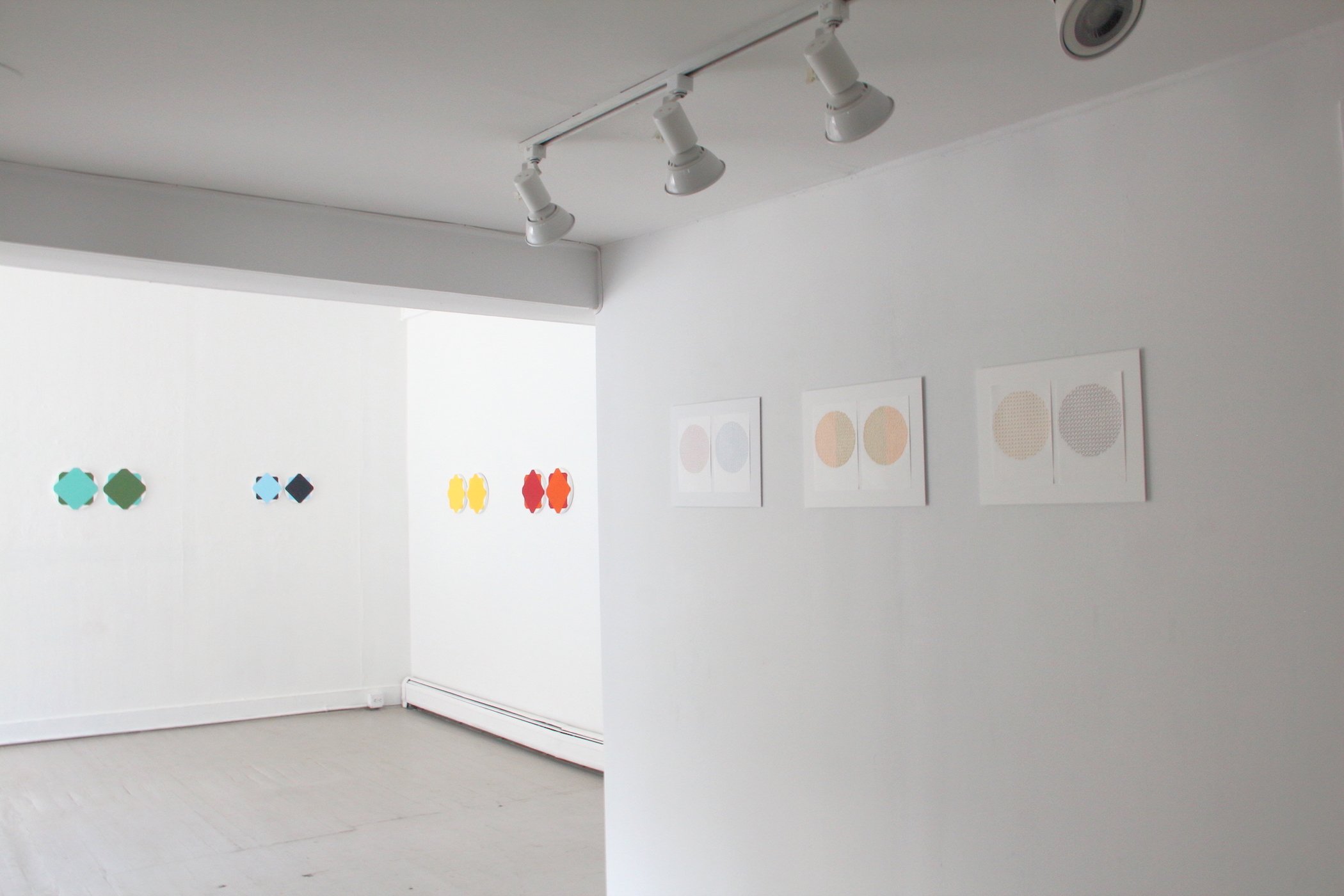Dyads, 57W57 Arts, NY 2024 (Installation view).
Installation view of Dyads, 57W57 Arts, New York, NY. Photo credit: Riley Palmer.
Installation view of Dyads, 57W57 Arts, New York, NY.
All Together Now, Garrison Art Center, Garrison, NY 2022 (Installation view).
Patricia Zarate’s work is fueled by personal experiences, creating images that are conjured from sensory observations and memory. Using a variety of media, Zarate explores the ways in which we perceive color and light through simple abstract shapes. Color relationships are formed by employing pairing, seriality, pattern, repetition, uniformity, and space.
—Garrison Art Center
Installation view of All Together Now, Garrison Art Center, Garrison, NY.
Installation view of All Together Now, Garrison Art Center, Garrison, NY.
Parallel Play, John Molloy Gallery, New York, NY 2021 (Installation view).
Featuring Artists: Jacob Cartwright, Daniel G. Hill, Mary Schiliro and Patricia Zarate
Installation view of Parallel Play at John Molloy Gallery, New York, NY. Photo credit: Daniel G. Hill
Installation view of Parallel Play at John Molloy Gallery, New York, NY. Photo credit: Daniel G. Hill.
Installation view of Parallel Play at John Molloy Gallery, New York, NY. Photo credit: Daniel G. Hill.
Installation view of Parallel Play at John Molloy Gallery, New York, NY. Photo credit: Daniel G. Hill.
Surfacing, MONO Practice, Baltimore, MD 2020 (Installation view).
Surfacing brings together six artists whose work employs pattern in various iterations. Repeated forms behave and misbehave-- looping in and out of systems and structures we might have previously understood as fixed. The visual patterns that emerge in Surfacing are drawn from a variety of external and internal sources -- aesthetic histories, cultural references, personal experience, and even studio daydreams. These patterns are places, times, people, communities. They are memory; personal and collective recollections made visual through shape. The artists here, in different ways, argue against distinctions between ornamentation and content. Rather than having pattern act as a decorative device, artists in Surfacing instead use pattern as a way to bring forth the complex visual, cultural, and personal histories that underpin their work.
—Alex Paik and Mark Joshua Epstein, Curators
Installation view of Surfacing at MONO Practice, Baltimore, MD. Photo credit: MONO Practice.
Installation view of Surfacing at MONO Practice, Baltimore, MD. Photo credit: MONO Practice.
Uncharted: American Abstraction in the Information Age, Emily Lowe Gallery, Hofstra University Museum of Art, Hempstead, NY 2020 (Installation view).
Art, science, and technology have become increasingly intermingled. The distinctions between the disciplines are less clear, leading into unknown territory where all things are possible. The eight artists included in Uncharted: American Abstraction in the Information Age, drawn from the membership of the American Abstract Artists organization, explore some of the unexpected ways that math, science and technology are transforming our perception of the visual arts. Using a range of styles and materials, creating both two-dimensional, three-dimensional, and site-specific works, these artists investigate mathematical or scientific principles, in both explicit and implicit ways, and often use technology to produce their work. The works of art in the exhibition – by artists James O. Clark, John Goodyear, Lynne Harlow, Daniel G. Hill, Gilbert Hsiao, Irene Rousseau, James Seawright, and Patricia Zarate – can be difficult to categorize.
—Karen T. Albert, Curator
Installation view of Uncharted: American Abstraction in the Information Age, Emily Lowe Gallery, Hofstra University Museum of Art, Hempstead, NY. Photo credit: Hofstra University Museum of Art.
Installation view of Uncharted: American Abstraction in the Information Age, Emily Lowe Gallery, Hofstra University Museum of Art, Hempstead, NY.
Objectify, Trestle Gallery, Brooklyn, NY 2017 (Installation view).
Objectify presents work that defies categorization and moves in a space between painting and sculpture, image and object. objects engage the corners of the gallery, unroll onto the floor and slide under the walls.
—Daniel G. Hill and Mary Schiliro, Curators
Installation view of Objectify, Trestle Gallery, Brooklyn, NY. Photo credit: Daniel G. Hill.
Installation view of Objectify, Trestle Gallery, Brooklyn, NY. Photo credit: Daniel G. Hill.
Domestic Disturbances, 490 Atlantic Gallery, Brooklyn, NY, 2017 (Installation view).
Domestic Disturbances features the work of eight artists whose work merges functional and non-functional elements, highlighting the interplay of art and design. traditionally the use of craft and design was associated with domesticity, functionality and decoration. These classifications have contributed to a hierarchy that historically marginalized and devalued the art of women, minorities and non-western cultures. changes in cultural awareness precipitated by feminism, gender identity and racial diversity have shifted perceptions of aesthetic value and in turn softened divisions in the art world.
—Joanne Freeman, Curator
Installation view of Domestic Disturbances, 490 Atlantic Gallery, Brooklyn, NY, 2017. Photo credit: Joanne Mattera.
Installation view of Domestic Disturbances, 490 Atlantic Gallery, Brooklyn, NY, 2017. Photo credit: Joanne Mattera.
Five Corners, 57W57 ARTS - Project Space, New York, NY 2016 (Installation view).
Five Corners is a site-specific installation that engages the room’s architecture with an exploration of primary and secondary colors. Reflected Agenda references the Colombian flag, which consists of three bands of color: yellow, blue and red. Hung in the corners of the room, its three vertical paintings cast reflected glows on the walls. Also included is Triangular Mix, a work that reconfigures a rectangle into two triangles of secondary colors folded into the corners.
Installation view of Five Corners at 57W57 ARTS, New York, NY.
Installation view of Five Corners at 57W57 ARTS, New York, NY.
Installation view of Five Corners at 57W57 ARTS, New York, NY.
Pratt Alumni Exhibition, Pratt Institute, Brooklyn, NY 2015 (Installation view).
…this exhibition represent the tradition of abstract painting embedded in the culture of Pratt Institute. Working in the vein of notable alumni such as Ellsworth Kelly and Pat Steir, the visual vocabulary developed by each artist confronts the formal elements of color. Spanning four decades of alumni, the exhibition proves an ongoing dialogue with abstraction.
—Caroline Taylor, Curator
Installation view of Pratt Alumni Exhibition, Pratt Institute, Brooklyn, NY.
Unconfirmed Makeshift Museum:: UMM, Irvine, CA 2015 (Installation view).
Using the obsolete medium of slides, in “slide slam,” Zarate eviscerates the film to work on the slide frame itself, which she hand-paints, conjuring the idea of emptiness in a minimalist composition of blank wall pockets. The emphasis in “slide slam,” as well as in other works by Zarate, is on color relationships and on the cumulative effect of individual formal units, how they reconfigure and activate each other with their individual presence. Zarate eschews large heroic gestures, instead using modest materials that she associates with lived experience to build colorful compositions.
—Mariángeles Soto-Díaz, Curator
Installation view, UMM, Irvine, CA. Photo credit: Mariángeles Soto-Díaz
Slide Slam (detail), 2009/2013, acrylic on slide covers, dimensions variable
Doppler Shift, Visual Arts Center of New Jersey, Summit, NJ 2014 (Installation view).
In the eye of the beholder
A look at the works in doppler shift
This exhibition examines the relationship of the viewer to the work of art by investigating how shifting perspectives alter the visual experience. As various factors change—the viewing distance, angle of vision, lighting conditions, duration of looking—forms and objects seem to shift between two and three dimensions, creating spatial ambiguities and visual disorientation. The interaction of color and line may prompt similar optical sensations, making stationary lines and forms appear to move. The unconventional or unexpected placement of art objects creates interesting and playful juxtapositions that respond to the building’s architecture, with its angled walls, high and low ceilings and expansive windows.
—Mary Birmingham, Curator
Installation view of Doppler Shift, Visual Arts Center of New Jersey, Summit, NJ.
Open Studios, Castello Aragonese di Otranto, Bau Institute, Otranto, Italy 2013
I focused on creating work that drew from and/or was directly influenced by the physical space of the studio and the town of Otranto. Otranto is described, in the tourist websites, as boasting “deep intense crystal clear blue water and stark pristine white buildings” – reacting to this natural beauty, I created a site-responsive piece in the studio using these predominate colors.
Installation view of Open Studios, Castello Aragonese di Otranto, Bau Institute, Otranto, Italy.
Installation view of Open Studios, Castello Aragonese di Otranto, Bau Institute, Otranto, Italy.
759 Running Feet: Wall Drawings in Gwangju, Gwangju Art Museum, Gwangju, South Korea, 2005 (Installation view).
Zarate’s Across the Divide (2005) is a meditative dialogue between two locations: Hyanggyo in Gwangju and Sunnyside in Queens, where she resides. To represent these two remote places she has chosen the pattern from two religious sites. While a floral motif for Gwangju is taken from the architectural ornament of Daeseongjeon (a shrine), seemingly anonymous grid design is extracted from the facade of New York Presbyterian Church that houses a largely Korean congreation. Zarate placed these contrasting pictorial signs in facing walls of the gallery to evoke the geographical distance of the two sites as well as to suggest the ubiquity of cultures found in our everyday.
— Hitomi Iwasaki, Associate Curator, Queens Museum of Art
Installation view of Across the Divide at Gwangju Art Museum, Gwangju, South Korea.
Installation view of Installation view of Across the Divide at Gwangju Art Museum, Gwangju, South Korea.


























